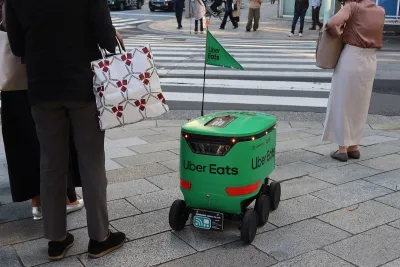Ride-hailing and scooter companies blindsided cities. They shouldn’t let delivery robots do the same.

Writing in Policy Options, Gavin MacGregor and Mischa Young argue that cities should develop strategies for mitigating the negative impacts of delivery robots and “ensure this intrusive technology does not disadvantage city sidewalk users.”
As MacGregor and Young note, delivery robots, which have been deployed in cities around the world, can “impede pedestrian flow, cause discomfort and amplify navigation challenges in crowded pedestrian environments.” Larger and heavier robots could mean a higher risk of injuries if they collide with pedestrians. “Broader adoption of delivery robots could turn less frequent incidents into a wider problem for pedestrians, cyclists and wheelchair users.”
The authors point out that the proliferation of delivery robots could disproportionately impact people with mobility challenges and the elderly. “Too often, the deployment of new urban technologies focuses on those who stand to benefit while overlooking those who could be excluded or burdened by them.”
The authors write that cities could avoid getting blindsided in the same way they did when ride-hailing companies like Uber were suddenly introduced on city streets to ensure the technology is deployed safely and equitably, not at the expense of vulnerable populations and public space. “A proactive and pre-emptive policy framework is essential to mitigate potential challenges associated with the widespread deployment of these delivery technologies.”
FULL STORY: Cities need to get ahead of autonomous delivery robots

National Parks Layoffs Will Cause Communities to Lose Billions
Thousands of essential park workers were laid off this week, just before the busy spring break season.

Retro-silient?: America’s First “Eco-burb,” The Woodlands Turns 50
A master-planned community north of Houston offers lessons on green infrastructure and resilient design, but falls short of its founder’s lofty affordability and walkability goals.

Delivering for America Plan Will Downgrade Mail Service in at Least 49.5 Percent of Zip Codes
Republican and Democrat lawmakers criticize the plan for its disproportionate negative impact on rural communities.

Test News Post 1
This is a summary

Test News Headline 46
Test for the image on the front page.

Balancing Bombs and Butterflies: How the National Guard Protects a Rare Species
The National Guard at Fort Indiantown Gap uses GIS technology and land management strategies to balance military training with conservation efforts, ensuring the survival of the rare eastern regal fritillary butterfly.
Urban Design for Planners 1: Software Tools
This six-course series explores essential urban design concepts using open source software and equips planners with the tools they need to participate fully in the urban design process.
Planning for Universal Design
Learn the tools for implementing Universal Design in planning regulations.
EMC Planning Group, Inc.
Planetizen
Planetizen
Mpact (formerly Rail~Volution)
Great Falls Development Authority, Inc.
HUDs Office of Policy Development and Research
NYU Wagner Graduate School of Public Service





























